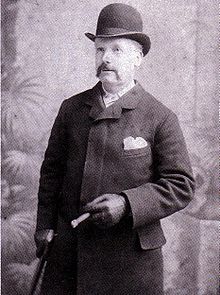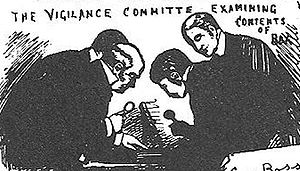- Whitechapel Vigilance Committee
-
 George Lusk, President of the Whitechapel Vigilance Committee.
George Lusk, President of the Whitechapel Vigilance Committee.
The Whitechapel Vigilance Committee was a group of local volunteers who patrolled the streets of London's Whitechapel District during the period of the Whitechapel murders of 1888. The volunteers patrolled mainly at night in the search for the murderer. The committee was set up by local businessmen who were concerned that the killings were affecting trade in the area. It was led by George Lusk, a local builder who was elected chairman during the committee's first meeting on 10 September 1888.[1]
Other committee members included Mr. Joseph Aarons, the landlord of The Crown public house on Mile End Road (treasurer), Mr. B. Harris (secretary),[2] and Messrs. Cohen, H. A. Harris, Laughton, Houghton, Lord, Isaacs, Rogers, Mitchell, Barnett, Hodgkins, Lindsay, Reeves, and Jacobs. The Daily Telegraph reported on 5 October 1888 that the leading members of the committee were "drawn principally from the trading class, and include a builder, a cigar-manufacturer, a tailor, a picture-frame maker, a licensed victualler, and 'an actor.'"[3] The latter was probably the entertainer Charles Reeves.
As chairman of the committee, Lusk's name appeared in the national newspapers and on posters in Whitechapel appealing for information concerning the identity of Jack the Ripper and complaining about the lack of a reward for such information from the government. Due to this publicity, Lusk received threatening letters through the post, allegedly from the murderer. Lusk is also mentioned in a letter dated 17 September 1888, reportedly discovered among archive materials in the late 20th century; however, most experts dismiss this as a modern hoax.[4]
On 30 September 1888 the committee members wrote to the government under Lord Salisbury in an attempt to persuade them to offer a reward for information leading to the apprehension of the killer. When the Home Secretary Henry Matthews refused, the committee offered its own reward.[1] The committee also employed two private detectives, Mr. Le Grand (or Grand) and Mr. J. H. Batchelor,[2] to investigate the murders without the involvement of the local police.
The committee was unhappy with the level of protection that the community was receiving from the police, so it introduced its own system of local patrols, using hand-picked unemployed men to patrol the streets of the East End every evening from midnight to between four and five the next morning. Each of these men received a small wage from the Committee, and patrolled a particular beat, being armed with a police whistle, a pair of galoshes and a strong stick. The committee itself met each evening at nine in the The Crown, and once the public house closed at 12.30 a.m. the committee members would inspect and join the patrols. These patrols were shortly to be joined by those of the Working Men's Vigilance Committee.[5]
The "From Hell" letter, which was sent with half of a human kidney, was posted to the committee's chairman George Lusk, who received it on October 16, 1888.[6] Many scholars[who?] of the Jack the Ripper murders regard this letter as being the communication most likely have to been sent by the killer.[7]
References
- ^ a b "Jack the Ripper Timeline". Casebook: Jack the Ripper. http://www.casebook.org/timeline.html.
- ^ a b Eddleston, John J. 'Jack the Ripper: An Encyclopedia' Published by ABC-CLIO (2001) pg 139 ISBN 1576074145
- ^ Daily Telegraph 5 October 1888
- ^ "Ripper Letters". Casebook: Jack the Ripper. http://www.casebook.org/ripper_letters/.
- ^ Sugden Philip 'The Complete History of Jack the Ripper' Robinson, London (1995)
- ^ "The East London Horrors. An Extraordinary Parcel". Casebook: Jack the Ripper. http://www.casebook.org/press_reports/west_ham_guardian/881020.html.
- ^ "From Hell: Fact or Fiction?". Casebook: Jack the Ripper. http://www.casebook.org/dissertations/dst-fromhellfact.html.
External links
- The Whitechapel Vigilance Committee on the Casebook: Jack the Ripper website
- The Whitechapel Vigilance Committee on the London Walks website
Jack the Ripper Canonical victims Police Frederick Abberline · Robert Anderson · Thomas Arnold · Walter Dew · George Godley · Donald Swanson · Charles WarrenLetters and clues Dear Boss letter · Saucy Jacky postcard · From Hell letter · Openshaw letter · Goulston Street graffitoCategories:
Wikimedia Foundation. 2010.

